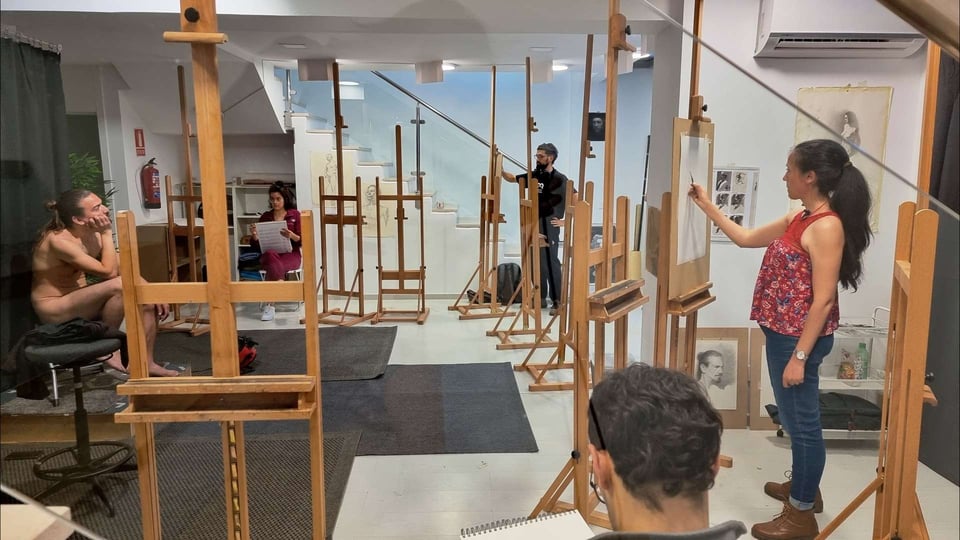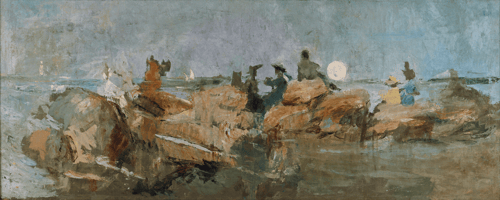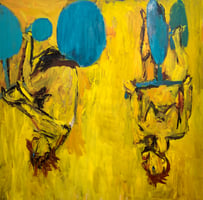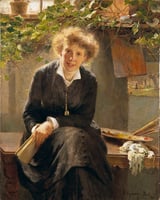Ignacio Pinazo Martínez (born in Sagunto, Valencia, in 1849 - died in Madrid in 1916) was a Spanish...
Mastering Figurative Art: A Complete Guide

Embark on a journey to master the timeless craft of figurative art, exploring essential techniques, contemporary influences, and practical tips for creating captivating works.
Introduction to Figurative Art
Step into the enchanting realm of figurative art and embark on a captivating journey that delves deep into the essence of the human experience. While abstract art may soar on the wings of forms and colors, figurative art roots itself in the depiction of tangible objects and subjects, with a special emphasis on the intricate nuances of the human figure. This art form carries with it a diverse history, ranging from the classical masterpieces of ancient times to the bold and expressive interpretations found in contemporary works. By immersing yourself in this rich tapestry of history, you can unravel the intricate layers of complexity and depth that define figurative art, allowing for a profound appreciation of its enduring legacy. So, let your imagination soar and explore the boundless possibilities that await you in the world of figurative art.
Key Techniques in Figurative Art
Exploring the realm of figurative art is like embarking on a journey into a world where the canvas becomes a portal to bring subjects to life in a myriad of ways. From the luscious texture of oils that add a richness and depth to a piece, to the intricate linework of graphite that delicately captures the nuances of the human form, each medium offers a unique avenue for artists to express themselves. And let's not forget the dramatic flair that charcoal brings to the table, with its bold shading and contrast that adds a dynamic element to any artwork.
To truly master these mediums, artists must be willing to dedicate themselves to the craft, to patiently hone their skills through practice and experimentation. Tutorials and workshops can serve as invaluable tools, offering insights and techniques on how to manipulate these materials effectively. By delving into different approaches and styles, artists can carve out their own niche within the vast landscape of figurative art, infusing their work with a personal touch that speaks volumes about their creativity and expression.
The Importance of Anatomy in Figurative Art
As you delve deeper into the study of anatomy, you begin to unravel the intricate connections between form and function, exploring the intimate relationship between structure and movement. Each muscle, tendon, and bone tells a story of resilience and adaptability, highlighting the marvel of human physiology. Through careful observation and practice, you not only sharpen your technical skills but also cultivate a profound appreciation for the intricacies of the human body.
Moreover, the study of anatomy transcends mere physicality; it delves into the realm of emotions and expressions, capturing the essence of what it means to be human. By understanding how muscles contract and relax, how bones support and shape our bodies, you gain a deeper insight into the subtleties of gesture and posture. These subtle cues convey a wealth of emotions, from joy and sorrow to determination and vulnerability, allowing you to infuse your artwork with a sense of authenticity and depth that resonates with viewers.
With each stroke of your pencil or brush, you breathe life into your creations, transforming them into dynamic and expressive representations of the human experience. The knowledge and skills you acquire through the study of anatomy serve as a powerful tool for storytelling, enabling you to craft figurative artworks that not only capture the likeness of your subjects but also evoke a profound emotional response. By honing your understanding of anatomy, you embark on a journey of artistic exploration, where every line, curve, and shadow becomes a narrative thread waiting to be woven into the tapestry of your artwork.
Contemporary Figurative Artists to Follow
In addition to Kehinde Wiley and Jenny Saville, the contemporary art scene is teeming with a diverse array of figurative artists who are reshaping the landscape of expression. Artists like Toyin Ojih Odutola, known for her intricate and layered portraits that challenge traditional narratives of identity and history, and Amy Sherald, celebrated for her bold and empowering depictions of African American subjects, are pushing the boundaries of figurative art in unique and compelling ways. Their innovative approaches to storytelling, use of color and texture, and exploration of identity and representation add a fresh and dynamic perspective to the genre, captivating audiences and sparking important conversations about art and society. As these visionary artists continue to redefine and expand the possibilities of figurative expression, they inspire a new generation of creators to explore their own voices, embrace authenticity, and engage with the world around them through their artistic endeavors.
Figurative Art in Digital Media
The digital revolution has not left figurative art untouched. In fact, it has opened up a whole new realm of possibilities for artists to explore. By blending traditional techniques with digital tools, artists can create works that are not only innovative but also rooted in classical training. Programs like Adobe Photoshop and Procreate have revolutionized the way artists approach their craft, offering a wide range of tools and effects that were previously unimaginable. These digital mediums provide artists with the opportunity to experiment with texture, color, and composition in ways that were once restricted to traditional methods.
With the advent of digital art, artists can now seamlessly combine the precision of digital tools with the artistic expression of figurative art. The use of technology allows for greater flexibility and experimentation, enabling artists to push the boundaries of their creativity and produce works that resonate with the timeless quality of figurative art. Whether it's creating a hyper-realistic portrait or exploring abstract interpretations of the human form, the possibilities are endless in the digital realm of figurative art.
How to Start a Figurative Art Piece
When embarking on the creation of a figurative artwork, it is crucial to establish a strong foundation that will serve as the backbone of your creative process. Begin by sketching out the initial composition with a mindful eye, carefully considering the placement of your subjects and the overall form of the piece. Delve into the interplay of light and shadow, as mastering this balance will bring dimension and depth to your subjects, infusing your artwork with a sense of realism and vitality that captivates viewers. Moreover, remember the significance of perspective in constructing a believable space for your figures to inhabit, allowing them to seamlessly interact with their surroundings in a way that feels organic and immersive. This initial stage not only sets the visual tone for your finished piece but also acts as a roadmap for the intricate details and nuances that will be added as your artwork evolves. By dedicating time and effort to this foundational phase, you pave the way for the creation of a compelling and impactful figurative artwork that resonates with viewers on a profound and emotional level.
Analyzing Famous Figurative Artworks
Studying masterpieces such as Michelangelo's 'David' or Botticelli's 'The Birth of Venus' not only offers an enriching journey into the intricate world of figurative art but also provides a profound insight into the artistic genius of these renowned creators. These iconic works stand as testaments to the artists' technical prowess and creative vision, showcasing a mastery of form, composition, and emotion that continues to captivate audiences across generations. By immersing oneself in the rich tapestry of symbolism and storytelling woven into these timeless pieces, viewers can embark on a visual and intellectual exploration of the cultural and historical contexts in which they were created. Through a process of critical analysis and reflection, one can unravel the layers of meaning embedded within these masterpieces, unlocking a deeper understanding of the complexities and significance of figurative art in shaping our understanding of the human experience. In essence, delving into these iconic artworks not only allows us to appreciate the skill and artistry of the artists but also invites us to connect with the universal themes and emotions that have resonated through the ages, reaffirming the enduring relevance and impact of figurative art on our collective artistic heritage.
Workshops and Resources for Learning Figurative Art
For those eager to delve deeper into the captivating world of figurative art, the possibilities for learning and growth are endless. In addition to the valuable resources mentioned, such as the classic 'Figure Drawing for All It's Worth' by Andrew Loomis and online platforms like Skillshare, there are a plethora of workshops and masterclasses available to provide hands-on experience and guidance.
For a more immersive experience with live models, Madrid Academy of Art offers a variety of programs at different levels and durations for personalized training. These hands-on workshops provide aspiring figurative artists with the unique opportunity to study anatomy, gesture, and expression in a dynamic and interactive setting. With experienced instructors guiding students through the intricacies of figurative art, participants can refine their technical skills, explore different artistic approaches, and gain a deeper understanding of the human form. By working directly from live models, students can practice capturing the nuances of gesture, posture, and emotion, allowing them to translate the complexities of the human body into compelling and authentic artworks. Whether you are a beginner looking to develop a strong foundation in figurative art or an experienced artist seeking to refine your techniques, the programs offered by Madrid Academy of Art provide a stimulating and enriching environment for artistic growth and exploration.
These immersive learning opportunities offer a chance to not only refine technical skills but also to explore different artistic approaches and styles under the guidance of experienced instructors.
Furthermore, art exhibitions play a crucial role in the education and inspiration of aspiring figurative artists. By immersing oneself in the diverse range of artworks on display, individuals can gain valuable insights into the techniques, themes, and creative processes employed by established artists. These exhibitions not only serve as a source of motivation but also offer a platform for networking and connecting with fellow art enthusiasts and professionals.
Whether you are seeking to refine your skills, explore new artistic horizons, or simply immerse yourself in the beauty and complexity of figurative art, the abundance of resources available ensures that there is always something new and exciting to discover. Embrace the journey of artistic exploration, and let your passion for figurative art guide you towards endless possibilities for growth and creativity.
Challenges and Rewards of Figurative Art
Figurative artists often face a multitude of challenges in their creative process, from the daunting task of accurately capturing the likeness of their subjects to effectively conveying emotions and mastering composition. These hurdles require unwavering perseverance, a keen eye for detail, and a relentless dedication to honing their craft. Despite the obstacles that may arise, the rewards of figurative artistry are immeasurable. Each completed piece represents not only a personal triumph but also a powerful means of communication, allowing artists to tell intricate and poignant human stories through the visual language of their creations.
By navigating the complexities of figurative art, artists unlock a profound sense of accomplishment as they breathe life into their subjects, infusing them with emotion, depth, and meaning. Through meticulous attention to detail and a deep understanding of the human form, artists can evoke a wide range of emotions and narratives, creating a connection with viewers that transcends language and cultural barriers. The ability to convey complex human experiences through visual media is a unique and powerful skill that figurative artists possess, offering a platform for introspection, empathy, and dialogue.
In essence, the challenges faced in the pursuit of figurative art are not merely obstacles to overcome but opportunities for growth, learning, and self-discovery. Each brushstroke, each line, and each composition presents a chance for artists to delve deeper into the nuances of human expression and storytelling, pushing boundaries and expanding their creative horizons. The rewards of mastering figurative art are not only personal but also universal, as artists have the ability to touch hearts, provoke thought, and inspire change through their art.
Closing Thoughts
Figurative art is not just a static form of expression; it is a dynamic journey of continuous learning and growth. It serves as a gateway to exploring the depths of human emotions, experiences, and relationships through the visual language of art. As you delve into the intricate world of figurative art, you embark on a profound and transformative exploration of the human condition. Whether you are an aspiring artist seeking to refine your skills or an enthusiastic admirer of the genre, the realm of figurative art beckons you to immerse yourself in its captivating narratives and timeless beauty.
Embracing figurative art allows you to not only hone your technical skills but also to cultivate a deeper understanding of the complexities and nuances of human expression. Through the careful study of form, composition, and emotion, you can unlock the power of storytelling through your artwork, creating pieces that resonate on a profound and emotional level with viewers. Each brushstroke, each color choice, and each composition offers a chance to convey the depth and complexity of the human experience, inviting others to connect with your art in meaningful and profound ways.
Your active participation in the world of figurative art is not only welcomed but cherished. Your unique perspective, feedback, and experiences enrich the artistic dialogue and community, fostering a shared sense of creativity, inspiration, and growth. Together, let us embrace the challenges and rewards of figurative art, pushing boundaries, igniting imaginations, and paving the way for a legacy of artistic expression that transcends time and resonates with generations to come. Let us continue to celebrate the enduring beauty and power of figurative art, uniting in our passion for creativity and storytelling through this captivating and evocative medium.




